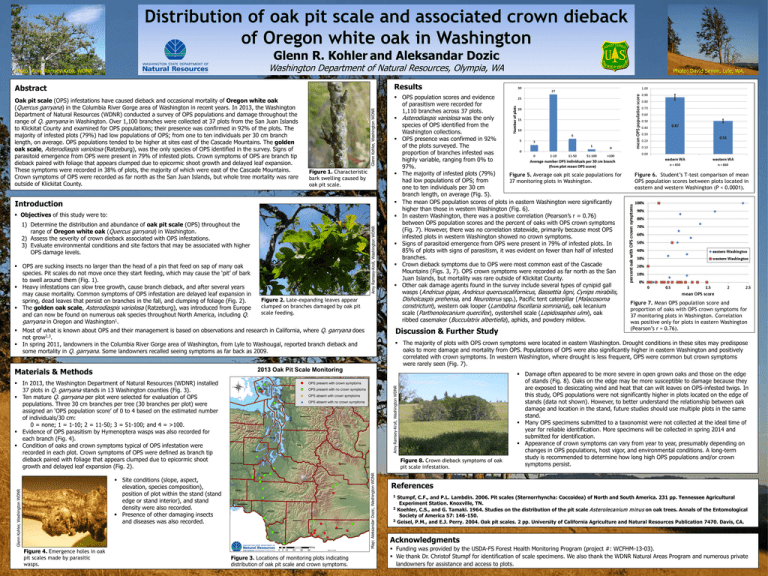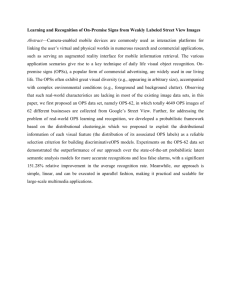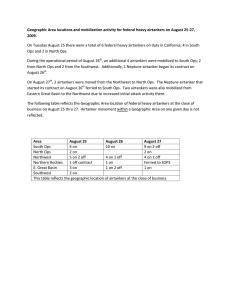Distribution of oak pit scale and associated crown dieback
advertisement

Distribution of oak pit scale and associated crown dieback of Oregon white oak in Washington Glenn R. Kohler and Aleksandar Dozic Washington Department of Natural Resources, Olympia, WA Photo: Amy Ramsey-Kroll, WDNR. Results Oak pit scale (OPS) infestations have caused dieback and occasional mortality of Oregon white oak (Quercus garryana) in the Columbia River Gorge area of Washington in recent years. In 2013, the Washington Department of Natural Resources (WDNR) conducted a survey of OPS populations and damage throughout the range of Q. garryana in Washington. Over 1,100 branches were collected at 37 plots from the San Juan Islands to Klickitat County and examined for OPS populations; their presence was confirmed in 92% of the plots. The majority of infested plots (79%) had low populations of OPS; from one to ten individuals per 30 cm branch length, on average. OPS populations tended to be higher at sites east of the Cascade Mountains. The golden oak scale, Asterodiaspis variolosa (Ratzeburg), was the only species of OPS identified in the survey. Signs of parasitoid emergence from OPS were present in 79% of infested plots. Crown symptoms of OPS are branch tip dieback paired with foliage that appears clumped due to epicormic shoot growth and delayed leaf expansion. These symptoms were recorded in 38% of plots, the majority of which were east of the Cascade Mountains. Crown symptoms of OPS were recorded as far north as the San Juan Islands, but whole tree mortality was rare outside of Klickitat County. Glenn Kohler, Washington WDNR Abstract Figure 1. Characteristic bark swelling caused by oak pit scale. Introduction 1) Determine the distribution and abundance of oak pit scale (OPS) throughout the range of Oregon white oak (Quercus garryana) in Washington. 2) Assess the severity of crown dieback associated with OPS infestations. 3) Evaluate environmental conditions and site factors that may be associated with higher OPS damage levels. OPS are sucking insects no larger than the head of a pin that feed on sap of many oak species. Pit scales do not move once they start feeding, which may cause the ‘pit’ of bark to swell around them (Fig. 1). Heavy infestations can slow tree growth, cause branch dieback, and after several years may cause mortality. Common symptoms of OPS infestation are delayed leaf expansion in Figure 2. Late-expanding leaves appear spring, dead leaves that persist on branches in the fall, and clumping of foliage (Fig. 2). clumped on branches damaged by oak pit The golden oak scale, Asterodiaspis variolosa (Ratzeburg), was introduced from Europe scale feeding. and can now be found on numerous oak species throughout North America, including Q. garryana in Oregon and Washington1. Most of what is known about OPS and their management is based on observations and research in California, where Q. garryana does not grow2,3. In spring 2011, landowners in the Columbia River Gorge area of Washington, from Lyle to Washougal, reported branch dieback and some mortality in Q. garryana. Some landowners recalled seeing symptoms as far back as 2009. Amy Ramsey-Kroll, Washington WDNR Objectives of this study were to: Amy Ramsey-Kroll, Washington WDNR Map: Aleksandar Dozic, Washington WDNR Figure 8. Crown dieback symptoms of oak pit scale infestation. Site conditions (slope, aspect, elevation, species composition), position of plot within the stand (stand edge or stand interior), and stand density were also recorded. Presence of other damaging insects and diseases was also recorded. Figure 3. Locations of monitoring plots indicating distribution of oak pit scale and crown symptoms. Figure 6. Student’s T-test comparison of mean OPS population scores between plots located in eastern and western Washington (P < 0.0001). Figure 7. Mean OPS population score and proportion of oaks with OPS crown symptoms for 37 monitoring plots in Washington. Correlation was positive only for plots in eastern Washington (Pearson’s r = 0.76). The majority of plots with OPS crown symptoms were located in eastern Washington. Drought conditions in these sites may predispose oaks to more damage and mortality from OPS. Populations of OPS were also significantly higher in eastern Washington and positively correlated with crown symptoms. In western Washington, where drought is less frequent, OPS were common but crown symptoms were rarely seen (Fig. 7). In 2013, the Washington Department of Natural Resources (WDNR) installed 37 plots in Q. garryana stands in 13 Washington counties (Fig. 3). Ten mature Q. garryana per plot were selected for evaluation of OPS populations. Three 30 cm branches per tree (30 branches per plot) were assigned an ‘OPS population score’ of 0 to 4 based on the estimated number of individuals/30 cm: 0 = none; 1 = 1-10; 2 = 11-50; 3 = 51-100; and 4 = >100. Evidence of OPS parasitism by Hymenoptera wasps was also recorded for each branch (Fig. 4). Condition of oaks and crown symptoms typical of OPS infestation were recorded in each plot. Crown symptoms of OPS were defined as branch tip dieback paired with foliage that appears clumped due to epicormic shoot growth and delayed leaf expansion (Fig. 2). Glenn Kohler, Washington WDNR OPS population scores and evidence of parasitism were recorded for 1,110 branches across 37 plots. Asterodiaspis variolosa was the only species of OPS identified from the Washington collections. OPS presence was confirmed in 92% of the plots surveyed. The proportion of branches infested was highly variable, ranging from 0% to 97%. The majority of infested plots (79%) Figure 5. Average oak pit scale populations for had low populations of OPS; from 37 monitoring plots in Washington. one to ten individuals per 30 cm branch length, on average (Fig. 5). The mean OPS population scores of plots in eastern Washington were significantly higher than those in western Washington (Fig. 6). In eastern Washington, there was a positive correlation (Pearson’s r = 0.76) between OPS population scores and the percent of oaks with OPS crown symptoms (Fig. 7). However, there was no correlation statewide, primarily because most OPS infested plots in western Washington showed no crown symptoms. Signs of parasitoid emergence from OPS were present in 79% of infested plots. In 85% of plots with signs of parasitism, it was evident on fewer than half of infested branches. Crown dieback symptoms due to OPS were most common east of the Cascade Mountains (Figs. 3, 7). OPS crown symptoms were recorded as far north as the San Juan Islands, but mortality was rare outside of Klickitat County. Other oak damage agents found in the survey include several types of cynipid gall wasps (Andricus gigas, Andricus quercuscalifornicus, Bassettia ligni, Cynips mirabilis, Disholcaspis prehensa, and Neuroterus spp.), Pacific tent caterpillar (Malacosoma constrictum), western oak looper (Lambdina fiscellaria somniaria), oak lecanium scale (Parthenolecanium quercifex), oystershell scale (Lepidosaphes ulmi), oak ribbed casemaker (Bucculatrix albertiella), aphids, and powdery mildew. Discussion & Further Study Materials & Methods Figure 4. Emergence holes in oak pit scales made by parasitic wasps. Photo: David Simon, Lyle, WA. Damage often appeared to be more severe in open grown oaks and those on the edge of stands (Fig. 8). Oaks on the edge may be more susceptible to damage because they are exposed to desiccating wind and heat that can wilt leaves on OPS-infested twigs. In this study, OPS populations were not significantly higher in plots located on the edge of stands (data not shown). However, to better understand the relationship between oak damage and location in the stand, future studies should use multiple plots in the same stand. Many OPS specimens submitted to a taxonomist were not collected at the ideal time of year for reliable identification. More specimens will be collected in spring 2014 and submitted for identification. Appearance of crown symptoms can vary from year to year, presumably depending on changes in OPS populations, host vigor, and environmental conditions. A long-term study is recommended to determine how long high OPS populations and/or crown symptoms persist. References 1 2 3 Stumpf, C.F., and P.L. Lambdin. 2006. Pit scales (Sternorrhyncha: Coccoidea) of North and South America. 231 pp. Tennessee Agricultural Experiment Station. Knoxville, TN. Koehler, C.S., and G. Tamaki. 1964. Studies on the distribution of the pit scale Asterolecanium m inus on oak trees. Annals of the Entomological Society of America 57: 146-150. Geisel, P.M., and E.J. Perry. 2004. Oak pit scales. 2 pp. University of California Agriculture and Natural Resources Publication 7470. Davis, CA. Acknowledgments Funding was provided by the USDA-FS Forest Health Monitoring Program (project #: WCFHM-13-03). We thank Dr. Christof Stumpf for identification of scale specimens. We also thank the WDNR Natural Areas Program and numerous private landowners for assistance and access to plots.






